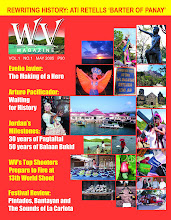 We are Back!
We are Back!By JO MARTINEZ–CLEMENTE, Editor
Unless I insist that all Filipinos came from the “royal oats” sown by the Bornean Datus when they first came into the country, I take no roots nor bearing in Western Visayas. And so I insist – but with due respect to the people of the region.
I first came to Iloilo City in the early 80s as a delegate to the national congress of the College Editors Guild of the Philippines. It was a very fleeting visit, the place hardly remembered as we were more embroiled in the issues confronting student writers then than doing the rounds of the province.
I shunned another opportunity to frequent the area when I was with the public relations department of one of the top corporations in the country. For one reason or another, I wasn’t able to visit Iloilo or any part of the region (except Bacolod City) the eight years I was there even as I move about every nook and cranny of the Philippines. When I left the company, I had in my desk quite a number of unused plane tickets all bound for Iloilo.
Until recently, Western Visayas for me was synonymous only to big political names that come from the region: Drilon, Defensor, even Jose Pidal. It is also home to two provinces lodge among the country’s bottom 20, Antique and Guimaras. But a destination area for tourist as it is also host to Bacolod’s Masskara Festival and Aklan’s Ai-Atihan and yes, for better or for worst, the world renowned, Boracay.
Call it serendipity, but soon after, my succeeding engagements as consultant of the Philippine Office of an international development organization brought me to the inner depths of the region. My encounter with ordinary folks in Guimaras and Northern Iloilo brought back a sense of what I lost along the way. These are in areas where there is more water than land and how people cope with day to day concerns. I joined fisherfolks in the island barangay of Bangongon in Conception, Iloilo as they laid out artificial reefs in the sea. Together with the community at the Jordan Marine Reserve in Guimaras, we let out to its natural habitat a pawikan. The interest spawned by these discoveries led no more.
Skeptic to the hilt, I found fresh hopes in some of the local government officials I met from the region and believed once again that there is still hope for the country.
And then I remembered. As an aspiring writer, I looked up to Graciano Lopez Jaena, one of Jaro’s most illustrious sons. In the days of our student activism, we took our hats off to one Antonio Tagamollila, an Ilonggo. And now I know that Guimaras and Antique are no longer in the list of the country’s poorest but are two of the most promising areas in the country.
In sum, Western Visayas for me has ceased to be a simple spot on the map. Whatever reasons fate has for shutting me out of the area in the past is probably the same reason why the area was superimposed before my very countenance now.
Be that as it may, I take liberty in saying all this to lend a bit of transparency as to who I am and why am I here and in doing so, be allowed to just move about without having to insist that I too, came from the barren soil sown and enriched by Datu Sumakwel and his peers.



No comments:
Post a Comment